Abstract
A monocyclic interconvertible enzyme cascade, in which active and inactive states of an enzyme are interconverted by two opposing enzyme-catalysed reactions, does not necessarily produce a greater degree of sensitivity to an effector than one could expect from direct interaction between effector and target reaction. On the contrary, a cascade in which an effector acts on one of the enzymes catalysing the interconversion reactions by altering the apparent value of its specificity constant will always generate a less sensitive response than direct interaction would give. Nonetheless, even if both interconversion reactions obey Michaelis-Menten kinetics with the ordinary types of inhibition and activation, one can easily generate an enormous sensitivity in which a 0.5% change in concentration can increase the proportion of target enzyme in the active state from 10% to 90%: this corresponds approximately to a Hill coefficient of 800. To maximize the sensitivity, the following conditions must be satisfied: (1) both modifier enzymes must act under conditions of near saturation; (2) the effector must act on both of them in opposite directions; (3) it must alter the apparent values of their catalytic constants; (4) the enzyme subject to inhibition by the effector must respond at much lower effector concentrations than the enzyme subject to activation. As the last of these conditions appears to be counter-intuitive, it suggests that feeble activation of modifier enzymes in real systems may have passed unnoticed, or been dismissed as physiologically insignificant, although in reality crucial to the effective response of the system.
Full text
PDF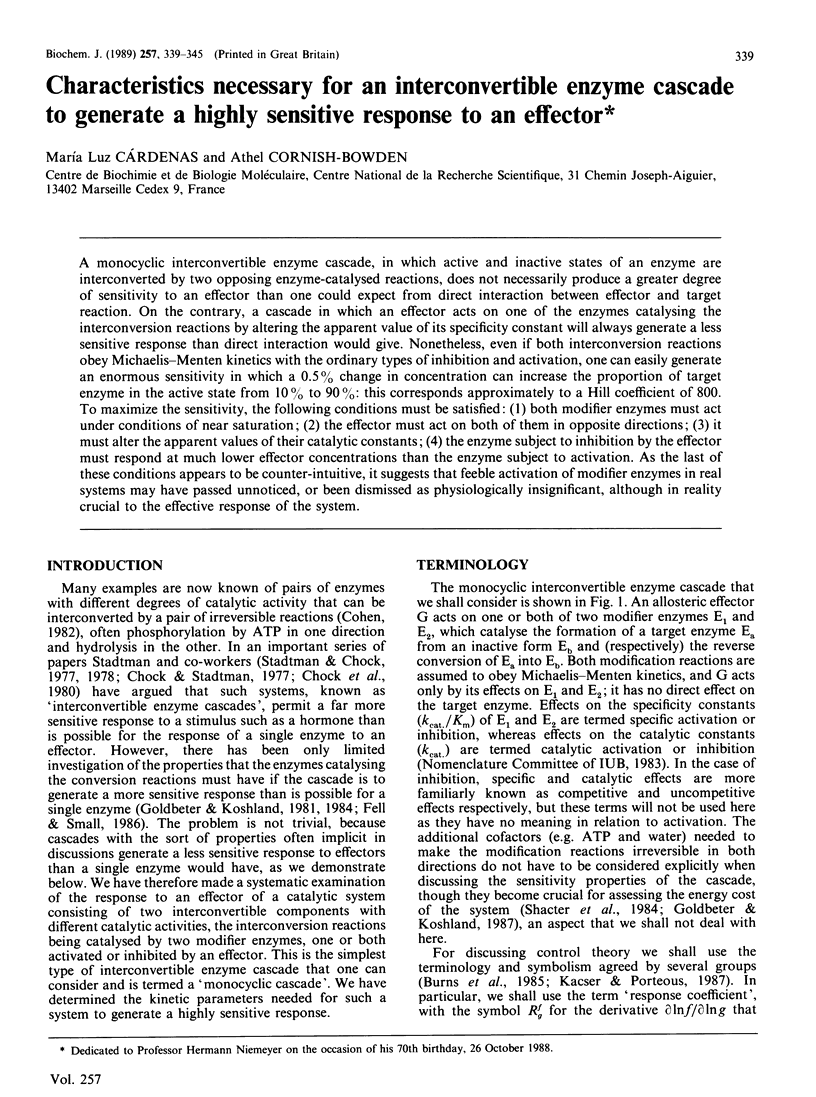
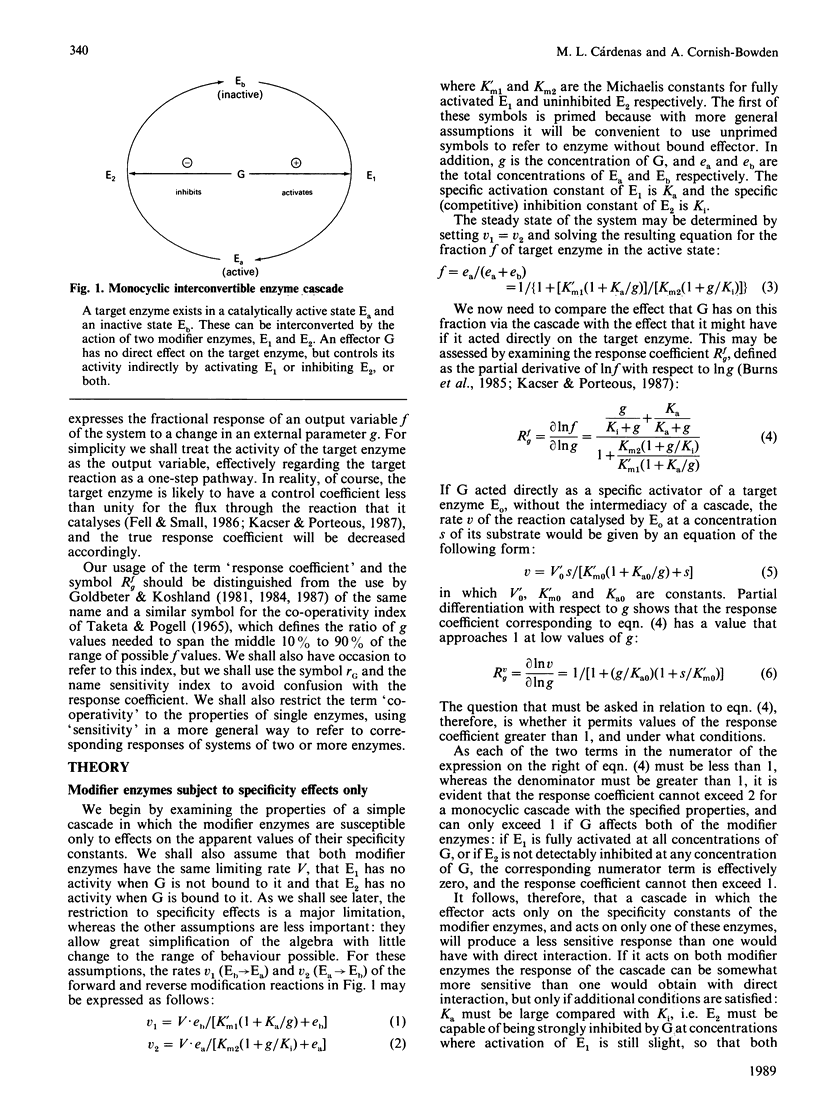
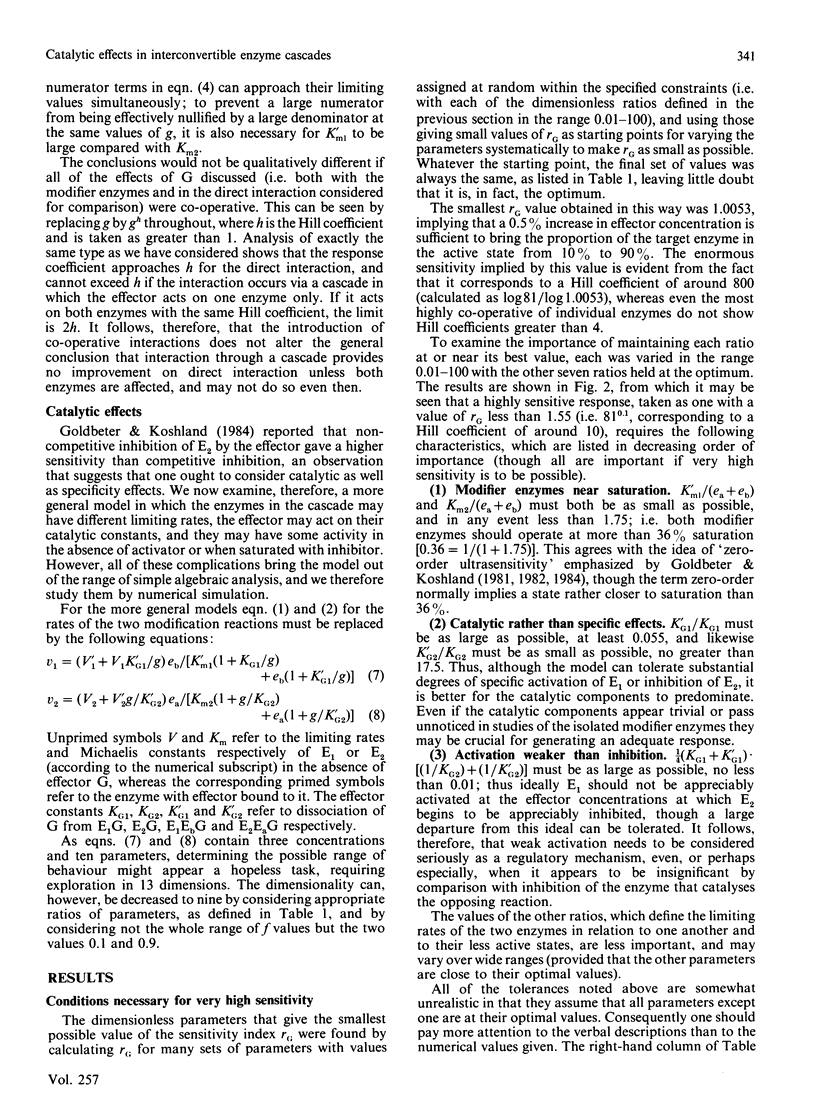
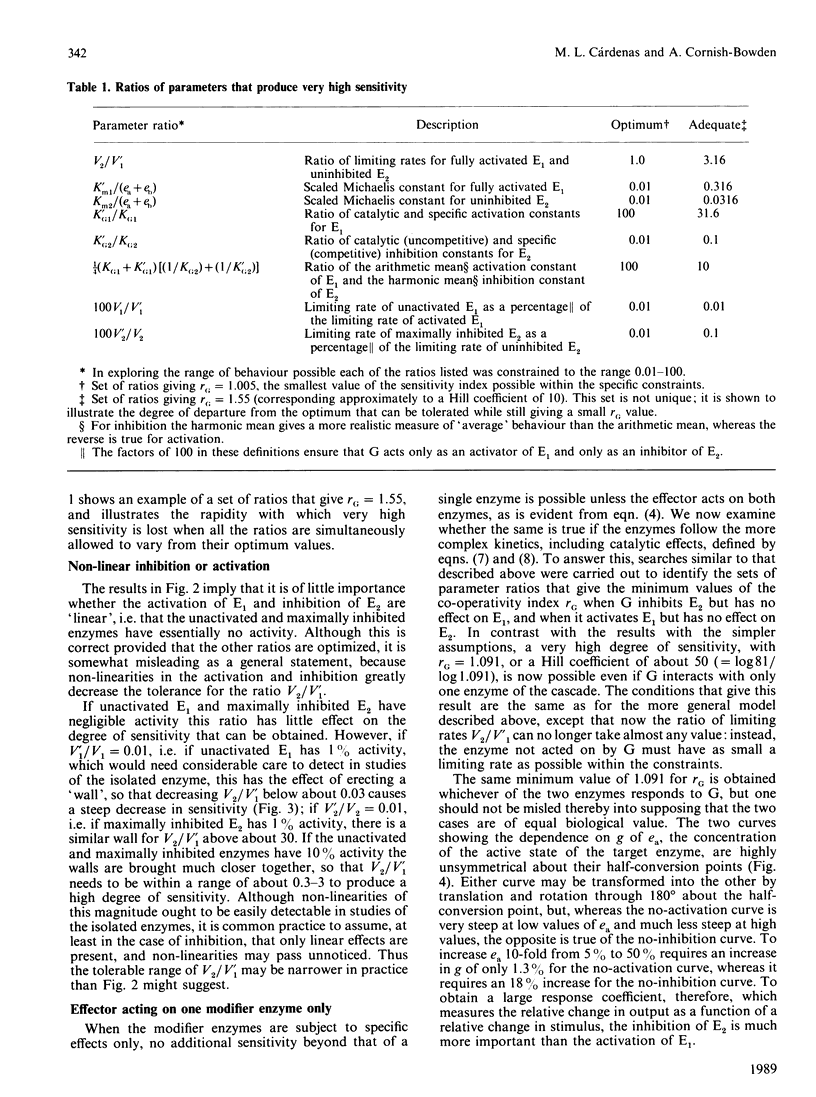
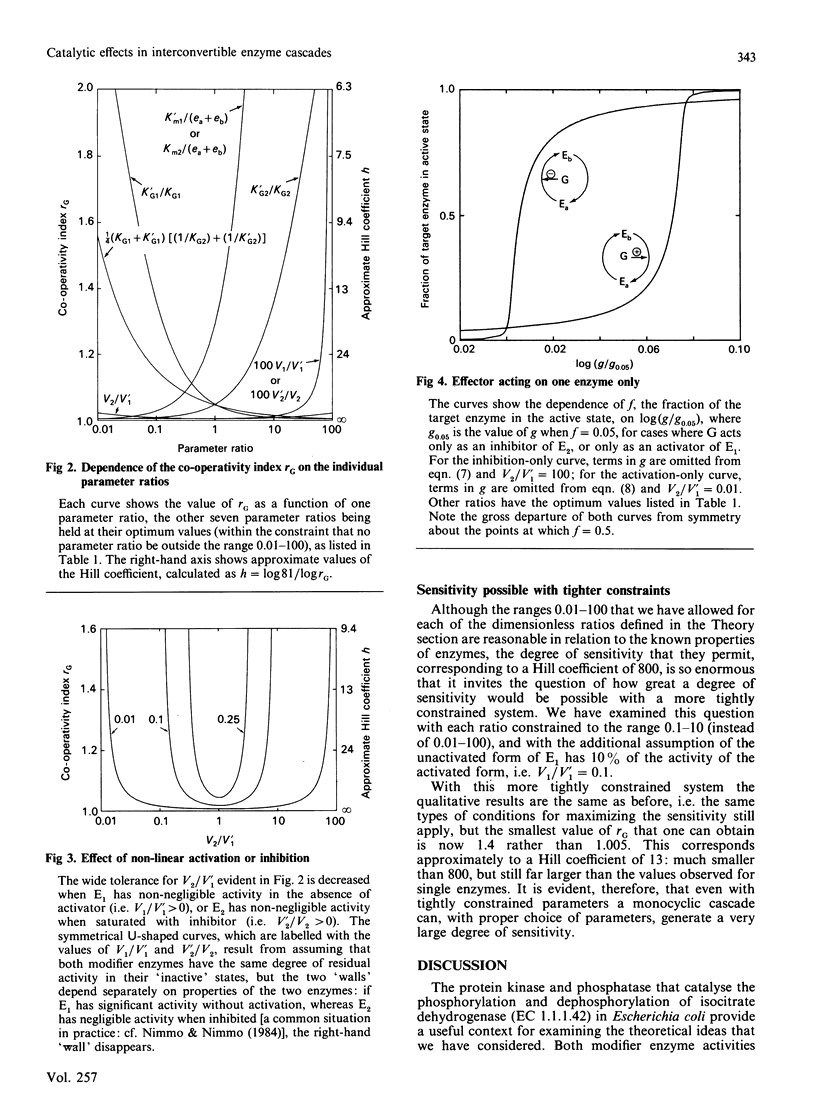


Selected References
These references are in PubMed. This may not be the complete list of references from this article.
- Boocock M. R., Coggins J. R. Kinetics of 5-enolpyruvylshikimate-3-phosphate synthase inhibition by glyphosate. FEBS Lett. 1983 Apr 5;154(1):127–133. doi: 10.1016/0014-5793(83)80888-6. [DOI] [PubMed] [Google Scholar]
- Chock P. B., Rhee S. G., Stadtman E. R. Interconvertible enzyme cascades in cellular regulation. Annu Rev Biochem. 1980;49:813–843. doi: 10.1146/annurev.bi.49.070180.004121. [DOI] [PubMed] [Google Scholar]
- Chock P. B., Stadtman E. R. Superiority of interconvertible enzyme cascades in metabolite regulation: analysis of multicyclic systems. Proc Natl Acad Sci U S A. 1977 Jul;74(7):2766–2770. doi: 10.1073/pnas.74.7.2766. [DOI] [PMC free article] [PubMed] [Google Scholar]
- Chock P. B., Stadtman E. R. Superiority of interconvertible enzyme cascades in metabolite regulation: analysis of multicyclic systems. Proc Natl Acad Sci U S A. 1977 Jul;74(7):2766–2770. doi: 10.1073/pnas.74.7.2766. [DOI] [PMC free article] [PubMed] [Google Scholar]
- Cohen P. The role of protein phosphorylation in neural and hormonal control of cellular activity. Nature. 1982 Apr 15;296(5858):613–620. doi: 10.1038/296613a0. [DOI] [PubMed] [Google Scholar]
- Cornish-Bowden A. Why is uncompetitive inhibition so rare? A possible explanation, with implications for the design of drugs and pesticides. FEBS Lett. 1986 Jul 14;203(1):3–6. doi: 10.1016/0014-5793(86)81424-7. [DOI] [PubMed] [Google Scholar]
- Garcia E., Rhee S. G. Cascade control of Escherichia coli glutamine synthetase. Purification and properties of PII uridylyltransferase and uridylyl-removing enzyme. J Biol Chem. 1983 Feb 25;258(4):2246–2253. [PubMed] [Google Scholar]
- Goldbeter A., Koshland D. E., Jr An amplified sensitivity arising from covalent modification in biological systems. Proc Natl Acad Sci U S A. 1981 Nov;78(11):6840–6844. doi: 10.1073/pnas.78.11.6840. [DOI] [PMC free article] [PubMed] [Google Scholar]
- Goldbeter A., Koshland D. E., Jr Energy expenditure in the control of biochemical systems by covalent modification. J Biol Chem. 1987 Apr 5;262(10):4460–4471. [PubMed] [Google Scholar]
- Goldbeter A., Koshland D. E., Jr Sensitivity amplification in biochemical systems. Q Rev Biophys. 1982 Aug;15(3):555–591. doi: 10.1017/s0033583500003449. [DOI] [PubMed] [Google Scholar]
- Goldbeter A., Koshland D. E., Jr Ultrasensitivity in biochemical systems controlled by covalent modification. Interplay between zero-order and multistep effects. J Biol Chem. 1984 Dec 10;259(23):14441–14447. [PubMed] [Google Scholar]
- LaPorte D. C., Chung T. A single gene codes for the kinase and phosphatase which regulate isocitrate dehydrogenase. J Biol Chem. 1985 Dec 5;260(28):15291–15297. [PubMed] [Google Scholar]
- LaPorte D. C., Koshland D. E., Jr A protein with kinase and phosphatase activities involved in regulation of tricarboxylic acid cycle. Nature. 1982 Dec 2;300(5891):458–460. doi: 10.1038/300458a0. [DOI] [PubMed] [Google Scholar]
- Nimmo G. A., Nimmo H. G. The regulatory properties of isocitrate dehydrogenase kinase and isocitrate dehydrogenase phosphatase from Escherichia coli ML308 and the roles of these activities in the control of isocitrate dehydrogenase. Eur J Biochem. 1984 Jun 1;141(2):409–414. doi: 10.1111/j.1432-1033.1984.tb08206.x. [DOI] [PubMed] [Google Scholar]
- Shacter E., Chock P. B., Stadtman E. R. Energy consumption in a cyclic phosphorylation/dephosphorylation cascade. J Biol Chem. 1984 Oct 10;259(19):12260–12264. [PubMed] [Google Scholar]
- Stadtman E. R., Chock P. B. Interconvertible enzyme cascades in metabolic regulation. Curr Top Cell Regul. 1978;13:53–95. doi: 10.1016/b978-0-12-152813-3.50007-0. [DOI] [PubMed] [Google Scholar]
- TAKETA K., POGELL B. M. ALLOSTERIC INHIBITION OF RAT LIVER FRUCTOSE 1,6-DIPHOSPHATASE BY ADENOSINE 5'-MONOPHOSPHATE. J Biol Chem. 1965 Feb;240:651–662. [PubMed] [Google Scholar]


